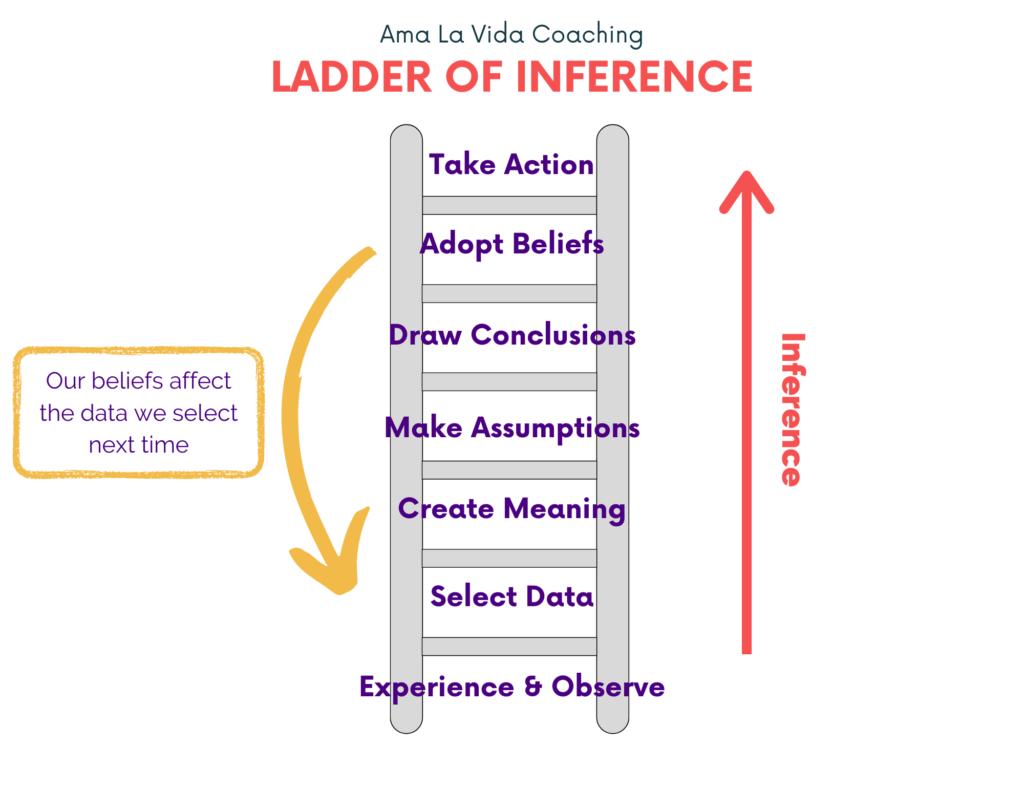How To Become a Better Communicator At Work
Career Enrichment, Self Awareness

Let’s start with a question: Would you rather break up with someone or tell a coworker that you’re bothered by something they did? In a survey, most people picked the dumping over the difficult work-related conversation (No Hard Feelings, pg. 139). In my opinion, there is something seriously wrong with that data point. How can it be that we’re so terrified and avoidant of hard work-related conversation?
My clients and I always talk about interpersonal problems and how to become a better communicator in the workplace. Their thoughts sounds a lot like: Joe from Accounting is getting on my nerves. Sara from Marketing is SO cold (she must hate me). I think everyone thinks I’m the office bitch… I always ask my clients to show me the evidence, and guess what? There usually is none! No hard facts to prove their assumptions – just lots of emotions.
I want to share a tool that will support you in becoming a better communicator at work and doing something about it without getting emotional. Let’s dive in!
You Know What They Say About Assuming…
Have you ever brought up an issue to another person and found yourself completely dumbfounded by the fact that they couldn’t see it from your perspective? That’s because we tend to jump to conclusions through a mental model called the “Ladder of Inference.” First described by organizational psychologist Chris Argyris, and later popularized by Peter Senge, the model explains how we quickly and unconsciously move from the facts of a situation to a conclusion (and why our conclusions are sometimes wrong).

Check Yourself…
…you know the rest! It’s so easy to send a passive-aggressive email or stew in the frustration of miscommunication and let resentment build up. The Ladder of Inference teaches us that we’re really good at unconsciously moving from observation to action.
If you take only one thing away from this blog post, let it be this: Give yourself time to slow down. When something happens at work, whether it’s a comment from a coworker that rubbed you the wrong way or a missed deadline, take a moment to label what you’re feeling. Are you hurt, frustrated, disappointed? Dive deeper by trying to understand where your feelings are coming from and check where you are on the Ladder of Inference.
The Ladder of Inference in Action
We’ll be taking the role of Malia. Malia is the manager of a development team at a mid-sized technology company, and her whole department has been under a lot of stress lately. They have a lot of projects and not enough capacity, with tight deadlines looming above their heads.
Malia’s direct report, Jack, walks in nearly half an hour late and quickly thanks to the office manager for taking his call. Malia decides to take action right away, and as soon as Jack is settled at his desk, she tells him that being late is unacceptable and that if it happens again, they will have to have a serious discussion about it.
Let’s review how Malia arrived at her decision to take the action of confronting Jack right away.
1. Observing available data
There are facts and reality all around us. The first step is to observe data.
Example: Jack shows up 20 minutes late, looking frazzled and frustrated, and stops by to thank the receptionist for taking his call.
2. Selecting your data or reality
Our realities are based on what we choose to gather as data. Step 2 is where we choose the data that fits our perspective.
Example: Jack shows up 20 minutes late.
3. Interpreting what it means
After we select our reality, we assign meaning to it based on our past experiences, memories, and biases.
Example: Malia has struggled with employee engagement in the past. The first sign of their disengagement was showing up late and having no respect for timelines. They were hard to work with and ended up leaving the company after a nasty disagreement.
4. Making or testing assumptions
Then, we make assumptions based on the meaning we created.
Example: Malia assumes that Jack is late because he has no regard for schedules or the deadlines they are under.
5. Drawing conclusions
From our assumptions, we conclude what needs to be done or what the right next step is. We haven’t considered all the facts, but we choose to come up with a conclusion based on our interpreted meaning.
Example: Malia decides Jack must be reprimanded for being late so this does not turn into a bigger issue and create problems the way it did for the past employees.
6. Adopt beliefs
Our conclusions lead us to cement a belief about the situation. We tend to use this belief over and over again when selecting data in the future, which becomes very problematic as our perspective narrows.
Example: Malia decides every employee that shows up late has no regard for schedules or deadlines and must be dealt with accordingly.
7. Take Action
Here is where we take action. You will notice that the action we take is usually based on our assumptions and conclusions, rather than facts.
Example: Malia immediately reprimands Jack and gives him a strict warning about respecting schedules and deadlines.
Check yourself and take a few deep breaths!

Pause and Reflect
Now that you’ve identified where you are on the ladder, it’s time to make your way down the ladder. Our goal is to go down to the “observable data and facts” rung, so we can untangle ourselves from our (perhaps incorrect) assumptions and stubborn beliefs into what’s actually there and what’s really true.
Below are some questions you can ask yourself and reflect on as you make your way down the ladder of inference. Start at the level you identified yourself to be on and work down from there:
- Action: Why have I chosen this course of action? Are there other actions I should have considered?
- Beliefs: What belief led to that action? Was it well-founded?
- Conclusions: Why did I draw that conclusion? Is the conclusion sound?
- Assumptions: What am I assuming, and why? Are my assumptions valid?
- Meaning: What does the selected data mean to me? Why is it this way? What biases am I bringing into this?
- Selected Data: What data have I chosen to use and why? Have I selected data rigorously?
- Observable data and facts: What are the real facts that I should be using? Are there other facts I should consider?
Reset and Rework
Congratulations! You made it to the bottom of the ladder. Hopefully, even just taking a little time to pause and reflect has already left you feeling a bit more calm and better about the situation overall. Now, let’s begin the climb back up the ladder and see what else is possible and how we can use this information to become a better communicator with colleagues, supervisors, and clients or customers.
During this step, you want to go up the rungs of the ladder and truly ask yourself “What else is possible?”
Taking the time to challenge your assumptions, conclusions, and beliefs will make you a stronger communicator and allow you to handle tough conversations from a more centered and calm perspective.
What would our example situation look like if Malia had taken the time to pause, reflect, reset, and rework? Work through the steps and see what other outcomes would be possible. Remember, we’re here if you need help!


